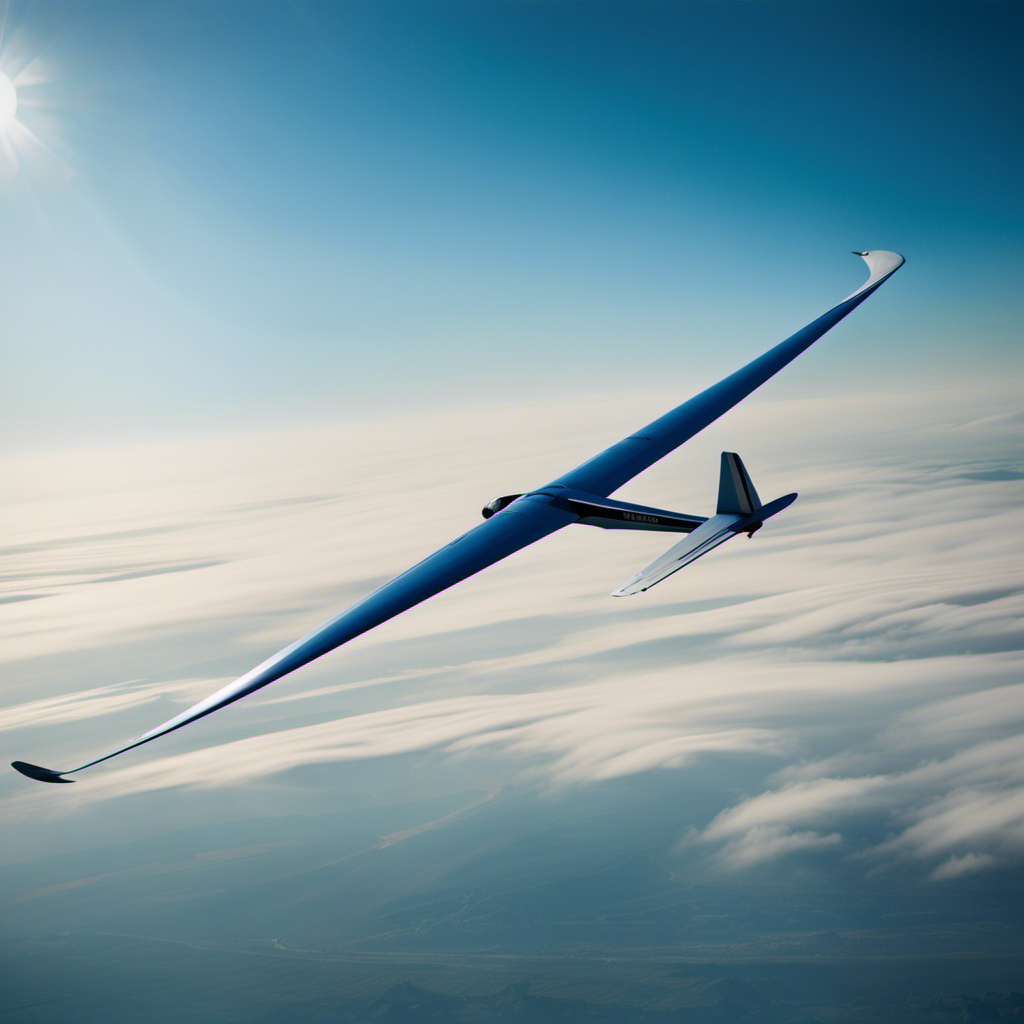Did you know that flying a glider requires precise handling skills and a deep understanding of aerodynamics? In the United States, there are over 20,000 glider pilots, making gliding through the air a popular and thrilling hobby.
In this article, I will guide you through the fundamentals of glider flight, from pre-flight preparations to mastering soaring techniques. Get ready to embark on an exhilarating journey as we explore the world of glider piloting and uncover the secrets to safe and smooth landings.
Key Takeaways
- Learn and practice landing techniques such as flare, slip, crab, and wheel landing
- Continuously educate yourself and develop advanced techniques like stalls, spins, and aerobatics
- Join a glider club or community to expand your skills, participate in competitions, and learn from experienced pilots
- Prioritize safety by following maintenance protocols, pre-flight checklists, and staying updated on airspace regulations and weather conditions.
Understanding the Basics of Glider Flight
Understanding the basics of glider flight is essential for successfully piloting a glider. To start, it is crucial to grasp the concept of glider aerodynamics. Gliders rely on the principles of lift and drag to stay airborne. By manipulating the control surfaces, such as the ailerons and elevators, pilots can control the glider’s pitch, roll, and yaw.
Another vital aspect is mastering thermals and ridge lift. Thermals are columns of rising warm air that glider pilots use to gain altitude. Ridge lift occurs when wind is forced upward by an obstacle, such as a mountain ridge. By flying close to the ridge, pilots can take advantage of this upward draft.
Understanding these fundamentals allows pilots to make informed decisions during a flight, ensuring a safe and enjoyable experience.
Transitioning into pre-flight preparations and safety checks, it is vital to thoroughly inspect the glider before taking off.
Pre-Flight Preparations and Safety Checks
Before taking off, it’s crucial to complete pre-flight preparations and safety checks. Ground handling techniques and weather considerations play a vital role in ensuring a safe and successful glider flight. To illustrate this, let’s take a look at the following table:
| Pre-Flight Preparations | Safety Checks | Ground Handling Techniques | Weather Considerations |
|---|---|---|---|
| Inspect the glider | Verify instruments | Secure the glider | Check wind conditions |
| Check control surfaces | Test emergency systems | Perform pre-takeoff checks | Monitor temperature |
| Evaluate weight and balance | Verify radio communication | Familiarize with launch procedures | Assess cloud cover |
Learning to Control the Glider on the Ground
Once you’ve completed the pre-flight preparations and safety checks, it’s time to learn how to control the glider on the ground. Ground handling is a crucial skill that every glider pilot must master before taking to the skies.
Here are some important points to keep in mind:
- Maintain a firm grip on the control bar to ensure precise control.
- Be aware of wind effects, as gusts can significantly impact the glider’s handling.
- Use weight shifting techniques to maintain balance and control during ground operations.
- Practice taxiing and maneuvering on the ground to simulate the movements you’ll make in the air.
Taking Off and Achieving Lift
When you’re ready to take off and achieve lift, remember to maintain a steady speed and apply the correct control inputs to smoothly transition from ground to air.
Before taking off in a glider, it’s crucial to ensure that the aircraft is properly maintained. Regular glider maintenance includes inspecting the control surfaces, checking the airframe for any signs of damage, and verifying that all instruments and systems are functioning correctly.
Additionally, understanding wind patterns is essential for a successful takeoff. By studying the wind direction and speed, you can determine the most favorable runway or launch direction. This knowledge will help you position the glider for maximum efficiency and lift.
Once you’ve mastered these techniques, you can move on to mastering soaring techniques, which will allow you to stay aloft for extended periods without the need for an engine.
Mastering Soaring Techniques
To master soaring techniques, you’ll need to learn how to effectively use thermals and ridge lift to gain altitude and sustain flight. Here are three key strategies to consider:
-
Utilize thermals: Thermals are columns of rising warm air that can provide a glider with significant lift. By identifying and circling within thermals, you can gain altitude and extend your flight time.
-
Harness ridge lift: When wind encounters a hill or mountain, it can create an upward flow of air known as ridge lift. By flying close to the ridge, you can take advantage of this upward motion and maintain altitude.
-
Explore cross country flying techniques: Once you have mastered thermals and ridge soaring, you can progress to cross country flying. This involves navigating between different sources of lift, planning efficient routes, and optimizing your flight path.
Navigating and Understanding Air Traffic Patterns
After mastering soaring techniques, it is crucial to understand how to navigate and interpret air traffic patterns when piloting a glider. Navigating air currents requires a keen understanding of wind patterns and their effects on the glider’s flight path. By analyzing weather reports and studying wind charts, pilots can identify areas of lift and sink, enabling them to make informed decisions on where to fly.
Additionally, effective communication with air traffic control is paramount for safe and efficient glider operations. Pilots must adhere to specific radio frequencies and follow instructions regarding airspace restrictions and traffic separation. To aid in this process, glider pilots often use a table like the one below to record important air traffic control information, ensuring clear and accurate communication.
Mastering these skills is essential for successful glider piloting and sets the foundation for managing emergency situations and implementing safety measures.
Transition: Now that we have discussed navigating and understanding air traffic patterns, let’s delve into managing emergency situations and implementing safety measures.
Managing Emergency Situations and Safety Measures
In case of an emergency, it’s important to remain calm and follow safety protocols.
As a glider pilot, I understand the significance of having well-defined emergency procedures and being equipped with the necessary safety equipment.
One of the first steps is to assess the situation and determine the severity of the emergency. If it’s a minor issue, like a radio failure, I can rely on standard procedures to address it.
However, in more critical situations, such as a structural problem, I must swiftly execute emergency protocols to ensure the safety of myself and the glider. This includes activating emergency communication devices, deploying emergency parachutes if available, and following any specific procedures outlined by the glider manufacturer.
Landing the Glider Safely and Smoothly
After learning how to manage emergency situations and prioritize safety measures, it is now time to focus on landing the glider safely and smoothly. This is a crucial skill that requires precision and careful consideration of wind conditions. By mastering various landing techniques, pilots can ensure a successful and controlled descent. To help you understand the importance of this skill, I have created the following table:
| Landing Technique | Description | Emotional Response |
|---|---|---|
| Flare | Gradually reducing the glider’s rate of descent | Confidence |
| Slip | Creating a side-slip to counter crosswind | Control |
| Crab | Aligning the glider with the runway at an angle | Adaptability |
| Wheel Landing | Touching down with the main wheel first | Stability |
| Short Field Landing | Utilizing a shorter portion of the runway for landing | Efficiency |
Mastering these techniques not only ensures a safe landing, but also evokes emotions of confidence, control, adaptability, stability, and efficiency. With this foundation, we can now move on to the next section about continuing education and advanced techniques, further enhancing our piloting skills.
Continuing Education and Advanced Techniques
Continuing education and advanced techniques enhance piloting skills, allowing for continuous improvement and growth. As a glider pilot, it’s essential to stay up to date with the latest advancements in the field. Here are some key areas to focus on:
-
Advanced maneuvers: Learning advanced techniques such as stalls, spins, and aerobatics can expand your abilities as a pilot and improve your overall control of the glider.
-
Glider competitions: Participating in glider competitions provides an opportunity to test your skills against other pilots, pushing you to perform at your best and learn from experienced competitors.
-
Navigation and weather analysis: Understanding how to analyze weather conditions and plan efficient flight routes is crucial for safe and successful glider operations.
-
Emergency procedures: Continuously refreshing your knowledge of emergency procedures and practicing simulated emergency scenarios will ensure you’re prepared for unexpected situations.
By continuously striving to improve in these areas, you’ll become a more skilled and confident glider pilot.
Transitioning into the subsequent section, joining a glider club or community for further adventures opens up a world of opportunities to learn from experienced pilots and engage in exciting flying experiences.
Joining a Glider Club or Community for Further Adventures
By joining a glider club or community, you can expand your horizons and embark on thrilling adventures while learning from experienced pilots. Glider clubs offer a wealth of opportunities to further your skills and knowledge in the world of gliding. One exciting aspect of being part of a glider club is the chance to participate in glider competitions and racing. These events provide a platform for pilots to showcase their skills and compete against fellow enthusiasts. Additionally, glider clubs often organize events and workshops focused on exploring glider aerobatics. This allows pilots to push the boundaries of flight and experience the exhilaration of performing aerobatic maneuvers in a glider. Joining a glider club or community is not only a way to expand your network but also a gateway to thrilling adventures and endless learning opportunities.
| Glider Competitions and Racing | Exploring Glider Aerobatics |
|---|---|
| Showcase skills and compete | Push the boundaries of flight |
| Competitive environment | Perform aerobatic maneuvers |
| Opportunities to learn from experienced pilots | Experience the exhilaration |
| Expand network | Endless learning opportunities |
Frequently Asked Questions
What are the common mistakes beginners make when learning to control a glider on the ground?
Common mistakes in ground control for beginners include improper weight distribution, failure to maintain a proper wing level, and inadequate use of controls. These errors can lead to difficulty in handling the glider and potential accidents.
How do glider pilots handle strong crosswinds during takeoff and landing?
When handling strong crosswinds during takeoff and landing, glider pilots must avoid common ground control mistakes. Proper technique involves using aileron and rudder inputs to maintain alignment with the runway and prevent drift off course.
What are the key indicators that help glider pilots identify thermals and areas of lift?
Identifying thermals and reading wind patterns are key indicators for glider pilots to locate areas of lift. By observing cloud formations, wind direction, and changes in air temperature, pilots can efficiently navigate and stay aloft.
How do glider pilots communicate with air traffic control while soaring in the sky?
During soaring flights, glider pilots utilize radio communication techniques to interact with air traffic control (ATC). Following ATC protocols and procedures ensures safe and efficient navigation in the sky.
What are some important safety measures that glider pilots should be aware of during emergency situations?
During emergency situations, glider pilots must follow strict emergency procedures to ensure safety. It is crucial to be familiar with safety precautions such as emergency landings, using emergency equipment, and communicating distress signals.
Conclusion
In conclusion, piloting a glider is an exhilarating experience that requires a solid foundation of knowledge and skills. By understanding the basics of glider flight and mastering techniques such as taking off, achieving lift, and soaring, one can truly soar like a bird in the sky.
It is crucial to prioritize safety and be prepared for emergency situations, while also continuously learning and improving. Joining a glider club or community can provide further opportunities for adventure and growth.
So, spread your wings and explore the world of gliding!
With a heart that soars as high as the skies, Aria, affectionately known as “Skylark,” is the driving force behind Soaring Skyways. Her journey into the gliding world began as a young dreamer gazing up at the soaring birds, yearning to experience the weightlessness and freedom they embodied. With years of experience both in the cockpit and behind the scenes, Aria’s commitment to the gliding community is unwavering.










